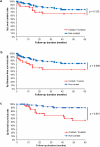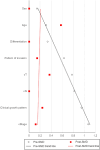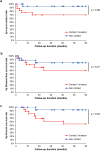Pterygomandibular raphe invasion as a novel grading and prognostic factor for squamous cell carcinoma of buccal mucosa: a retrospective study with propensity score matching
- PMID: 40643766
- PMCID: PMC12378123
- DOI: 10.1007/s10147-025-02821-2
Pterygomandibular raphe invasion as a novel grading and prognostic factor for squamous cell carcinoma of buccal mucosa: a retrospective study with propensity score matching
Abstract
Background: Squamous cell carcinoma of the buccal mucosa (SCCBM) is a prevalent malignancy of the oral cavity with high morbidity and mortality rates. The pterygomandibular raphe (PMR) connects the oral cavity, pharynx, and masticator space, serving as a key anatomical landmark during surgical resection. However, PMR invasion into SCCBM remains poorly understood. This study assessed the prognostic significance of PMR invasion in patients with resectable SCCBM.
Methods: The study included 82 patients with SCCBM, excluding those with T4b, who underwent radical resection at Kumamoto University Hospital between 2000 and 2017. Patients were categorized into three groups based on PMR invasion patterns: non-contact, contact, and invasion. The relationship between PMR invasion and clinicopathological characteristics was analyzed using the Fisher's exact test. The Kaplan-Meier method, log-rank test, and propensity score-matched analyses were used for survival analysis.
Results: Contact or invasion into the PMR was significantly associated with advanced clinical T and N stages, clinical stage, endophytic growth pattern, high-grade invasion pattern, and poor tumor differentiation. Patients with PMR invasion had a higher proportion of recurrences in the buccal subcutaneous, mandibular, and masticator spaces. Univariate analysis indicated that contact- or invasion-type PMR invasion predicted worse overall survival (OS). The impact of PMR invasion on OS was confirmed using a propensity score-matched analysis.
Conclusion: This study revealed that PMR invasion is a potential novel grading and prognostic factor for resectable SCCBM, with significance in planning the extent of SCCBM resection.
Keywords: Buccal mucosa; Prognosis; Propensity score matching; Pterygomandibular raphe; Retrospective study; Squamous cell carcinoma.
© 2025. The Author(s).
Conflict of interest statement
Declarations. Competing interests: The authors declare no conflict of interest.
Figures



Similar articles
-
Tumor Budding as an Independent Prognostic Histopathological Marker in Oral Squamous Cell Carcinoma - An Indian Tertiary Care Center Experience.Turk Patoloji Derg. 2025;41(2):31-41. doi: 10.5146/tjpath.2025.13761. Turk Patoloji Derg. 2025. PMID: 40091314 Free PMC article.
-
Analysis of clinicopathological factors associated with recurrence after post operative radiotherapy in oral cavity squamous cell carcinoma.J Cancer Res Ther. 2025 Apr 1;21(3):558-566. doi: 10.4103/jcrt.jcrt_1425_24. Epub 2025 Jul 5. J Cancer Res Ther. 2025. PMID: 40616537
-
Survival benefit of postoperative chemotherapy in stage III lung squamous cell carcinoma based on SEER database analysis through propensity score matching.Sci Rep. 2025 Jul 1;15(1):22210. doi: 10.1038/s41598-025-07766-0. Sci Rep. 2025. PMID: 40596657 Free PMC article.
-
Impact of residual disease as a prognostic factor for survival in women with advanced epithelial ovarian cancer after primary surgery.Cochrane Database Syst Rev. 2022 Sep 26;9(9):CD015048. doi: 10.1002/14651858.CD015048.pub2. Cochrane Database Syst Rev. 2022. PMID: 36161421 Free PMC article.
-
Endoscopic and surgical resection of T1a/T1b esophageal neoplasms: a systematic review.World J Gastroenterol. 2013 Mar 7;19(9):1424-37. doi: 10.3748/wjg.v19.i9.1424. World J Gastroenterol. 2013. PMID: 23539431 Free PMC article.
References
-
- Sundermann BV, Uhlmann L, Hoffmann J et al (2018) The localization and risk factors of squamous cell carcinoma in the oral cavity: a retrospective study of 1501 cases. J Cranio-Maxillofac Surg 46:177–182. 10.1016/j.jcms.2017.10.019 - PubMed
-
- DeConde A, Miller ME, Palla B et al (2012) Squamous cell carcinoma of buccal mucosa: a 40-year review. Am J Otolaryngol 33:673–677. 10.1016/j.amjoto.2012.04.006 - PubMed
-
- Thankappan S, Nedumpillil S, Thomas V (2023) Clinicopathologic features and risk factors associated with oral squamous cell carcinoma (OSCC): a comprehensive descriptive study analyzing the burden of OSCC in a tertiary-level hospital in North Kerala, India. Indian J Cancer 60:534–541. 10.4103/ijc.ijc_203_21 - PubMed
-
- Ken-Ichi Nibu SY (2019) Report of head and neck cancer registry of Japan clinical statistics of registered patients, 47
MeSH terms
LinkOut - more resources
Full Text Sources
Medical

